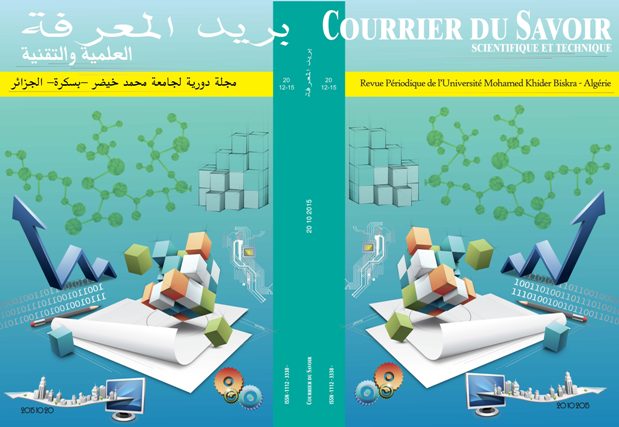ADSORPTION DE NITROBENZENE PAR UNE ARGILE NATURELLE ET UNE ARGILE ACTIVEE
Résumé
Le nitrobenzène est un intermédiaire de synthèse important utilisé pour la production industrielle des colorants, des matières plastiques, des pesticides, des explosifs et des produits pharmaceutiques. Il est présent sous forme des traces dans les effluents liquides issues de ces industries et constitue donc une pollution potentielle pouvant dégrader la faune et la flore, d’où la nécessité de trouver des techniques de traitement afin de minimiser les concentrations résiduelles de ce produit toxique dans les effluents avant rejets dans l’environnement. L’objectif de ce travail est l’étude de traitement des solutions synthétiques aqueuses de nitrobenzène par adsorption sur une argile naturelle et activée en batch. L’argile activée a été obtenue par l’attaque avec une solution métallique (Chlorure ferrique, FeCl3). L’équilibre a été atteint après 8 heures d’agitation pour l’argile naturelle et 4 heures pour l’argile activée. Les isothermes d’adsorption correspondantes suivent respectivement le modèle de Dubinin-Radushkevich pour l’argile naturelle et de Langmuir pour l’argile activée. Les rendements maximaux d’adsorption de nitrobenzène par l’argile naturelle et l’argile activée sont respectivement 37,5 % et 50 % à des concentrations initiales allant de 6,5 à 246 mg/L.
Références
[2] Haderlein S.B., Schwarzenbach. R.P. (1993). Adsorption of substituted nitrobenzenes and nitrophenols to mineral surfaces. Envron. Sci. Tech., 27, 316.
[3] Reynoso-Soto E.A., Sicairos. S.P. (2013). Photocatalytic degradation of nitrobenzene using nanocrystalline TiO2 photocatalyst doped with Zn ions. Mex. Chem. Soc, 57(4) , 298-305.
[4] Boyd S.A., Sheng GY., Teppen BJ., BJ.Johnston BJ. (2001). Mechanisms for the adsorption of substituted nitrobenzenes by smectite clays. Envron. Sc. Tech., 35, 4227.
[5] Makarova O.V., Rajh T., Thurnaue. M.C. , Martin A., Kemme P.A., Cropek D. (2000). Surface modification of TiO2 nanoparticles for photochemical reduction of nitrobenzene. Envron. Sci. Tech., 34, 4797.
[6] Latifoglu A., Gurol M.D. (2003). The effect of humic acids on nitrobenzene oxidation by ozonation and O3/UV processes. Water Res, 37, 1879.
[7] Beltran F.J., Encinar J.M., Alonso M.A. (1998). Nitroaromatic hydrocarbon ozonation in water.1. Single ozonation. Ind. Eng. Chem. Res., 37, 25.
[8] Jiao.W, Liu.Y, Liu.W, Li.J, Shao.F, Wang.C. (2013). Degradation of nitrobenzene-containing wastewater with O3 and H2O2 by high gravity technology. China. P.P and P. Tech., 15, 85-94.
[9] Franz M., Arafat H.A., Pinto N.G. (2000). Effect of chemical surface heterogeneity on the adsorption mechanism of dissolved aromatics on activated carbon. Carbon., 38, 1807.
[10] Anderson M.A. (2000). Removal of MTBE and other organic contaminants from water by sorption to high silica zeolites. Envron. Sci. Tech. 34, 725.
[11] Zhon S.Z., Jun M.A., Libo W., Lei Z. (2005). Degradation of nitrobenzene in aqueous solution by ozone-ceramic honeycomb. Envron. Sci. Tech. 17, 717-721.
[12] Chang C.Y, Tsai W.T., Ing C.H., Chang C.F. (2003). Adsorption of polyethylene glycol (PEG) from aqueous solution onto hhydrophobic zeolite. Col. Int. Sci. , 260 , 273.
[13] Chang C.F., Chang C.Y., Chen K.H., Tsai W.T., Shie J.L., Chen Y.H. (2004). Adsorption of naphthalene on zeolite from aqueous solution. Col. Int. Sci. 277, 29.
[14] Boulmokh A., Berredjem Y., Bensid N., Guerif K., Gheid A. (2006). Adsorption des colorants textiles par une argile modifiée. Annales de la faculté des sciences de l’ingénieur,1, 9-13.
[15] Perry R.H. (1997). Perry’ S Chemical Engineers Handbook, 6éme édition, Mc Graw-Hill.
[16] Arris.S, Benceikh M, Miniai.A. (2012). Batch adsorption of phenol from industrial wastewater using cereal by products as a new adsorbent. Energy Procedia, 18, 1135-1144.
[17] Singh K.P., Mohan D., Sinha S., Tondon G.S., Gosh D. (2003). Color removal from wastewater using low-cost activated carbon derived from agricultural waste maternal. Ind. Eng. Chem.Res. 42 , 1965.
[18] Lian.MS, Francis M. (2003).Techniques de l’Ingénieur, Traité de Génie des Procédés, 3éme édition, Mc Graw-Hill.
[19] Itodo.A.U, Itodo.H.U. (2010). Sorption energie estimation using Dubinin-Radushkevich and Temkin adsorption isotherms. Life science journal ,7, 31-39.
[20] Abdelkreem M. (2013). Adsorption of phenol from industrial wastewater using olive mill waste. APCBEE Procedia ,5 , 349-357.


